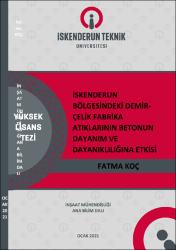| dc.contributor.advisor | Sevim, Umur Korkut | |
| dc.contributor.author | Koç, Fatma | |
| dc.date.accessioned | 2021-12-21T19:57:36Z | |
| dc.date.available | 2021-12-21T19:57:36Z | |
| dc.date.issued | 2021 | en_US |
| dc.date.submitted | 2021 | |
| dc.identifier.citation | Koc, F. (2021). İskenderun bölgesindeki demir-çelik fabrika atıklarının betonundayanım ve dayanıklılığına etkisi. (Yüksek Lisans Tezi). İskenderun Teknik Üniversitesi / Mühendislik ve Fen Bilimleri Enstitüsü, Hatay. | en_US |
| dc.identifier.uri | https://hdl.handle.net/20.500.12508/1936 | |
| dc.description.abstract | Günümüzde beton, çok fazla miktarda üretimi yapılan ve kullanılan yapı malzemesidir. Aynı şekilde çelik de üretimi ve kullanımı yaygın olan bir malzemedir. Çelik üretimi esnasında birçok yan ürün oluşmaktadır. Oluşan katma değerli bu yan ürünlerin malzeme olarak beton sektöründe kullanımı ekonomik ve çevresel sürdürülebilirlik açısından çok değerlidir. Bu çalışmada İskenderun bölgesinde faaliyet gösteren demir-çelik fabrikalarından elde edilen atık malzemelerin betonda agrega ve çimento yerine kullanılarak, beton üretimine ve teknolojisine geri dönüşümüne katkı sağlaması amaçlanmıştır. Betonda agrega yerine ince-kaba elektrik ark ocağı cürufu hacimce %25, %50, %100 oranlarında; siyah tufal ve kırmızı tufal ise %10, %20 oranlarında kullanılmıştır. Çimento yerine ise baca tozu ve yüksek fırın cürufu %10, %20, %30 oranlarında ağırlıkça değişim yapılmıştır.Belirlenen oranlarda 10×10×10 cm boyutlarında beton küp numuneler ve 10×20 cm boyutlarında silindir numuneler üretilmiştir. Toplam 19 farklı karışım tasarlanmıştır. Karışımlarda su/çimento oranı 0,5 ve bağlayıcı dozajı 400 kg/m³'te sabit tutulmuştur. Üretilen betonların ultrasonik ses geçiş hızı deneyi, 7 günlük ve 28 günlük basınç deneyleri yapılmıştır. Beton numuneler yüksek sıcaklığa (250 ºC, 500ºC, 750 ºC) 2 saat boyunca maruz bırakılarak basınç dayanımları tespit edilmiştir. 28 günlük numuneler 30 gün boyunca asit atağı ve sülfat atağına maruz bırakılarak sonrasında basınç dayanımları tespit edilmiştir. Silindir numuneler içerisine 12 mm çapında donatılar yerleştirilmiş, bu numuneler üzerinde kurulan düzenekle hızlı korozyon testi yapılmıştır. 152 saat boyunca donatılara sabit 12V akım verilmiştir. 8 saat aralıklarla donatılardan geçen akım ölçülmüştür. Elde edilen sonuçlar, çalışmada kullanılan geri dönüşüm malzemelerinin beton ve agrega yerine belirli oranlarda kullanılabilirliğini göstermiştir. | en_US |
| dc.description.abstract | Today, concrete is a building material that is produced and used in large quantities. Likewise, steel is a material that is widely produced and used. Many by-products are formed during steel production. The use of these value-added by-products in the concrete industry as a material is very valuable in terms of economic and environmental sustainability. In this study, it is aimed to contribute to the recycling of concrete production and technology by using waste materials obtained from iron and steel factories operating in Iskenderun region instead of aggregate and cement in concrete. In concrete, instead of aggregate, fine-coarse electric arc furnace slag is at 25%, 50% and 100% by volume; black scale and red scale were used at the rates of 10% and 20%. Instead of cement, flue dust and blast furnace slag 10%, 20% and 30% were changed by weight. Concrete cube samples of 10 × 10 × 10 cm and cylindrical samples of 10 × 20 cm were produced at the specified proportions. A total of 19 different mixtures were designed. The water / cement ratio in the mixtures was kept constant at 0.5 and the binder dosage at 400 kg / m³. Ultrasonic sound velocity test, 7-day and 28-day pressure tests of the produced concrete were performed. Concrete samples were exposed to high temperature (250 C, 500ºC, 750 ºC) for 2 hours and their compressive strength was determined. 28-day samples were exposed to acid and sulphate attack for 30 days and their compressive strength was determined afterwards. Reinforcements with a diameter of 12 mm were placed in the cylindrical samples, and rapid corrosion test was performed on these samples with the setup installed. Constant 12V current was supplied to the fittings for 152 hours. The current flowing through the reinforcement was measured at 8 hour intervals. The results obtained showed that the recycling materials used in the study can be used in certain proportions instead of concrete and aggregate. | en_US |
| dc.language.iso | tur | en_US |
| dc.publisher | İskenderun Teknik Üniversitesi / Mühendislik ve Fen Bilimleri Enstitüsü / İnşaat Mühendisliği Ana Bilim Dalı | en_US |
| dc.rights | info:eu-repo/semantics/openAccess | en_US |
| dc.subject | Yüksek fırın cürufu | en_US |
| dc.subject | Baca tozu | en_US |
| dc.subject | Elektrik ark ocağı cürufu | en_US |
| dc.subject | Tufal | en_US |
| dc.subject | Blast furnace slag | en_US |
| dc.subject | Chimney powder | en_US |
| dc.subject | Electric arc furnace slag | en_US |
| dc.subject | Mill scale | en_US |
| dc.title | İskenderun bölgesindeki demir-çelik fabrika atıklarının betonundayanım ve dayanıklılığına etkisi | en_US |
| dc.title.alternative | The effect of iron-steel factory wastes in the Iskenderun region on the strength and durability of concrete | en_US |
| dc.type | masterThesis | en_US |
| dc.contributor.department | Mühendislik ve Fen Bilimleri Enstitüsü | en_US |
| dc.relation.publicationcategory | Tez | en_US |
| dc.contributor.isteauthor | Sevim, Umur Korkut | |
| dc.relation.index | İndeks Bilgisi Yok | en_US |
















